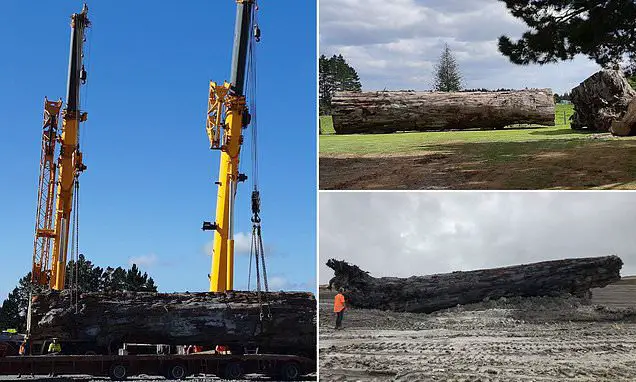The 40,000-year-old tree is the first ever found to have a record of Earth's magnetic field reversal.

(TMU) — In March 2019, an amazing discovery was made on New Zealand’s North Island. An ancient tree, the first and perhaps only specimen that exists, shows evidence of a reversal of Earth’s magnetic field. The Agathis Australis, known as a Kauri tree in Māori, was unearthed during the expansion of a geothermal power plant on North Island.
The Kauri was buried 26 feet (7.92m) underground and is 65 feet (19.81m) tall with a diameter of 8 feet (2.44m) and weighs 60 tons. Carbon dating revealed that the tree lived for about 1,500 years between 41,000 and 42,500 years ago.
Alan Hogg, from New Zealand’s University of Waikato, said: “There’s nothing like this anywhere in the world. This Ngāwhā kauri is unique.
The Kauri was alive during a period of time in Earth’s history when the magnetic field almost reversed. The magnetic north and south did not quite complete a full reversal.
The iron in Earth’s core is believed to generate the magnetic field. Earth’s movement causes electric currents which extend far into space, and the magnetic field creates a barrier to protect Earth from the solar wind. The solar wind, a stream of charged particles from the Sun could, could potentially strip away the ozone layer if it were to impact our atmosphere.
When the magnetic field reverses, successfully or not, more of the Sun’s radiation could get through. Scientists have linked previous extinction events to magnetic field reversals
The Kauri tree is the first tree found that has lived through a near reversal of the magnetic field and the tree rings show complete evidence of the near reversal. “It’s the time it takes for this movement to occur that is the critical thing… We will map these changes much more accurately using the tree rings,” Hogg said.
Chris Turney, paleoclimatology and climate change expert from the University of New South Wales, is leading a of group of scientists that is analyzing samples of the tree. Understanding what happened to the tree during the near reversal event could be helpful. Hogg explained, “We will have increased cosmic radiation. It will take out satellites and it might take out other communication infrastructure.”
Turney said: “The precious thing is this huge, lonely tree grew for some 1700 years across a remarkable period in our planet’s history when the Earth’s magnetic field flipped some 42,000 years ago, a period known as the Laschamp Excursion. Funded by the Australian Research Council we’re undertaking detailed measurements of the radioactive form of carbon through the tree rings.”
According to NASA, magnetic reversals seem to have happened once every 200,000 to 300,000 years in the last 20 million years, and the last full reversal happened some 780,000 years ago. However, it could also happen randomly.
Scientist revealed as recently as last year that the magnetic north pole had moved unexpectedly. Tracking from the Canadian Arctic to Siberia is usually steady but it sped up so much researchers had to renew the World Magnetic Model (WMM) at the end of 2020 of what would have been the usual five year period. Used worldwide by GPS systems, the WMM is a representation of Earth’s magnetic field and its accuracy is crucial to ensure safe navigation for aviation and shipping particularly in the Polar Regions.
“Because the Earth’s magnetic field has a major effect on how much radiocarbon is formed in the upper atmosphere, these precious analyses will allow us to investigate the magnitude and rate of change when the magnetic field reversed during the Laschamp; something not possible before and of great interest given recent changes in the Earth’s magnetic field,” Turney explained.
By Jade Small | Creative Commons | TheMindUnleashed.com
No comments:
Post a Comment